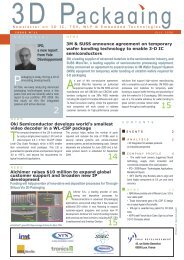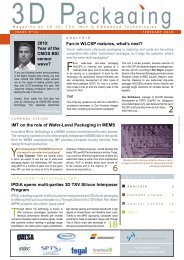September 2011 - I-Micronews
September 2011 - I-Micronews
September 2011 - I-Micronews
Create successful ePaper yourself
Turn your PDF publications into a flip-book with our unique Google optimized e-Paper software.
I S S U E N ° 1 3 S E P T E M B E R 2 0 1 1<br />
ZenithSolar expects to ship 1MW this<br />
year, two 10MW projects in pipeline<br />
Also now starting to ship systems for multiple new<br />
projects is Israel’s ZenithSolar, whose unique watercooled<br />
HCPV systems also supply significant amounts<br />
of hot water at 75°-80°C or more, hot enough for<br />
industrial as well as household uses. Now that the<br />
three-year-old company’s 250kW demonstration<br />
system at Kibbutz Yavne in Israel has been up and<br />
running for about 18 months, a half dozen other<br />
customers are stepping up to try the systems—<br />
perhaps a sign of the growing maturity of the HCPV<br />
sector. Zenith started shipping its first products to<br />
projects outside of Israel in March. It now has projects<br />
in the pipeline in Australia, Gulf states, Asia and Italy,<br />
for various applications that need a lot of hot water,<br />
ranging from hospitals to utility central heating plants<br />
to water desalinization projects. CEO Roy Segev says<br />
the company expects to ship a total of 1.2MW by the<br />
end of the year. These wattage figures totals include<br />
roughly one third direct production of electricity,<br />
roughly two-thirds the thermal energy of the hot water.<br />
The ZenithSolar system was designed for cogeneration,<br />
giving up some electrical efficiency in<br />
the interests of operating at higher temperature to<br />
create the extremely hot water needed for industrial<br />
applications. The dish mirror optics focus 850x-900x<br />
suns on a dense array of cells developed with Azur<br />
Space. The cell array is attached to a microchannel<br />
heat exchanger, similar to those used in the<br />
automotive industry, which heats the pressurized<br />
cooling water to close to 100°C so it can be piped<br />
away for other uses. That means the cell itself has<br />
to operate at a dauntingly high ~120°C, but Segev<br />
argues that the cells are rated to survive under these<br />
high temperatures, albeit with some loss of efficiency.<br />
Company materials also note that the cell array can<br />
be swapped out to upgrade the system later.<br />
Key to the technology, says Segev, is the company’s<br />
high temperature transparent encapsulation paste,<br />
which seals the glass directly to the cells to protect<br />
them from degradation from air or humidity. The<br />
trackers can be placed close together because they<br />
can tolerate some shading, as the optics consist of<br />
multiple rectangular facets, each about the size of<br />
the receiver array, and each independently continues<br />
to focus its light on the array, so any shading only<br />
reduces the concentration by that of the shaded<br />
facets. Like other companies in this young sector, as<br />
volumes have increased ZenithSolar has outsourced<br />
production of more of its initially internally designed<br />
and produced components.<br />
“A lot of customers were waiting to see the Yanev<br />
data base,” says Segev, referring to the demonstration<br />
project at the Israeli town of ~1000 that gets almost<br />
all its household hot water from the HCPV system,<br />
as well as all the hot water needed for its agricultural<br />
ZenithSolar parabolic dish system<br />
(Courtesy of ZenithSolar)<br />
P V M a n u f a c t u r i n g<br />
7
















